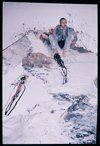




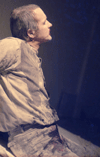
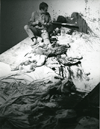
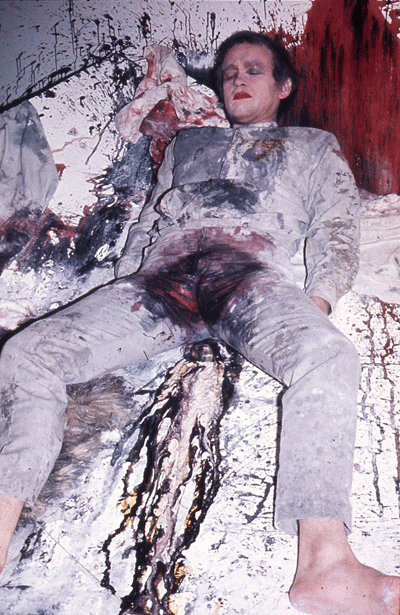
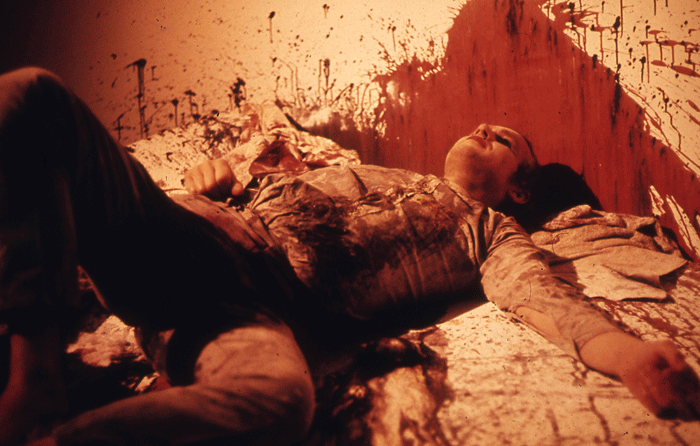
Artist as Whore 1972
Artist as Whore took place at Gallery House London in December before Xmas in 1972.
The subject is obvious in the title. Discordancy of the word 'whore' leads the way.
I took the image of whore as an analogy for the role of the artist as a complicit partner in the market place with its echoes of feudal accumulation.
This reveals a further fold; the artist, detached from the market place, has no one place to go or to be.
The event itself
In the event, Artist as Whore at times resembled a tableau. Nothing moved for minutes at a time. Actions were slow, intimate, motivated by the attempt to utilise taboos, as in being dirty, close and contradictorily seductive in appearance.
The performance lasting for a week was restricted to three or four hours per day in the afternoons.
The passive figure lay on a generously proportioned sloping bed structure two to three times the size of a double bed, solid, but appearing to be unstable. There were sheets and an animals skin lying across it in a rumpled state. The bed was resting against a wall at the back of a large domestic sized room, the back of it being about 10 degrees higher than the front. Generous amounts of fluids, red and thinned black paint were thrown against the wall and the bed. White flour was laid over the surface of most of the bed.
The bed as a receptacle for the figure was choreographed to suggest evidence of unspecified bodily activity by the presence of representations of blood and other less defined substances, and not least the occasional doses of urine. Complementary to this was the presentation of the painted head.
What the figure wore, it's appearance, the audience
A dirty looking white shirt with some faded stains on it. A pair of light coloured jeans with faded stains. The crotch area liberally stained from red to brownish black.
The head was painted a mid grey tone reducing the naturalism of the figure. Kohl was applied to the area around the eyes and lipstick to the lips.
The action was confined to movements stimulated by the need to move after long periods of lying still propped up on the bed awaiting an audience. The figure urinated when the urge came without opening clothing, which was followed by trickles slowly spreading and running down to the bottom of the bed. Everything about the work was unclean and adulterated.
The performance had a sense of listlessness in the intrusive coldness of the room.
Effects of consciously hidden urinations disturbing to the public.
I was relieved that the audience was sparse. I chose the Christmas period anticipating a low attendance. I was trying to build an atmosphere which would intensify when there were two or three people in the room. Not all events or performances depend on as large an audience as possible. The value of being able to influence the size of an audience to a limited degree enables the artist to conceive of works where the relative presence of a few people becomes a significant factor in the reading of works. Members of the audience then also become performers when they exhibit a reduction or shredding of self consciousness. If not, they become consciously conspicuous and will leave. An audience as witness where the figure in action is working among a few people is able to project a concentrated attention in the presence of others. In this relationship the rise and fall of the dialectic rhythm becomes a primary interlocutor.
I did not commission a photographer but was receptive to the idea that the work could be photographed, which it was by two or three people according to my memory. Subsequently images were passed to me. Working this way, there is a consciousness of the use of the camera in enlarging the constituency of viewers beyond the live time frame.
Stuart Brisley, Dungeness, April 2018